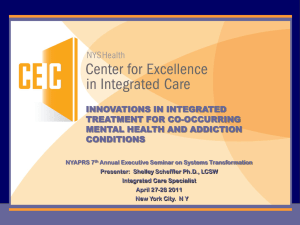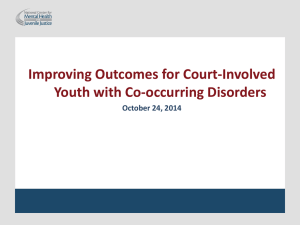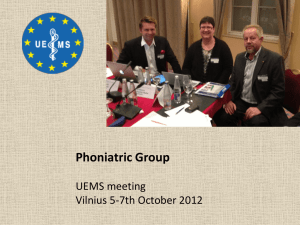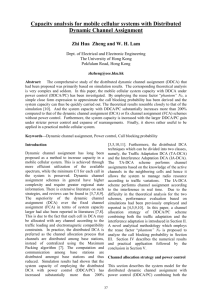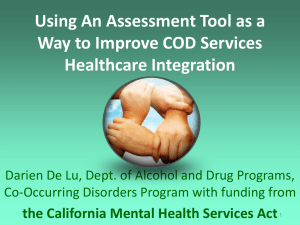Co-Occurring Disorders Center for Excellence (COCE)
advertisement
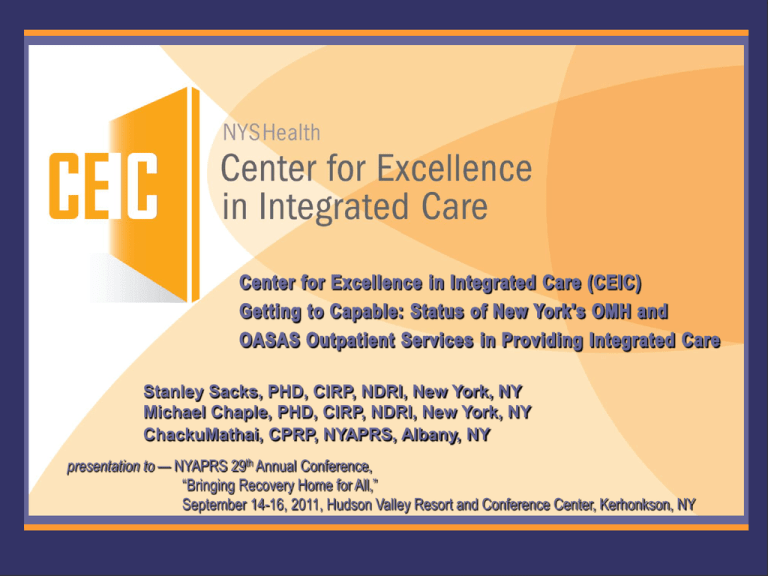
Stanley Sacks, PHD, CIRP, NDRI, New York, NY Michael Chaple, PHD, CIRP, NDRI, New York, NY ChackuMathai, CPRP, NYAPRS, Albany, NY presentation to — NYAPRS 29th Annual Conference, “Bringing Recovery Home for All,” September 14-16, 2011, Hudson Valley Resort and Conference Center, Kerhonkson, NY 1 What is CEIC’s purpose? Fosters the implementation of integrated care in screening, assessment, and evidence-based interventions for New York State (NYS) residents with co-occurring conditions and facilitates OMH and OASAS initiatives in this area 2 Timeline May, 2007 December, 2007 June 20 & July 31, 2008 November 1, 2008 New York State (NYS) Office of Alcoholism & Substance Abuse Services (OASAS) and Office of Mental Health (OMH) convene a Co-occurring Disorders (COD) Task Force (2007) The NYS COD Task force makes recommendations The Directors of licensed substance abuse and mental health programs receive two letters with recommendations for integrating services for COD from the Commissioners of OASAS and OMH The New York State Health Foundation (NYSHealth) funds the Center for Excellence in Integrated Care (CEIC, pronounced “seek”) 3 What does CEIC do? Provides technical assistance (hands-on, intensive, and longitudinal) Engages Leadership Performs on-site assessments Presents site reports Conducts provider forums Builds collaborations and informal networks Holds Peer Recovery Workshops Supplies ongoing support, guidance, and consultation Links programs to resources, such as FIT, TIP 42, and related inservice training, as well as other trainings and curricula 4 CEIC Assessment Methods Uses DDCA[MH]T (Dual Disorder Capability in Addiction Treatment and Dual Disorder Capability in Mental Health Treatment) Samples individual clinics within regions Employs direct onsite observation Scores and reports on 7 domains and overall Makes specific recommendations to raise capability 5 Improving Co-occurring Capability Recommendations by DDCA[MH]T Dimensions Dimensions of Capability Levels of Capability SA/MH only Capable Enhanced I Program Structure Program mission, structure and financing, format for delivery of co-occurring services II Program Milieu Physical, social and cultural environment for persons with mental health and substance use problems III Clinical Process:[screening &] Assessment Processes for access and entry into services, screening, assessment &diagnosis IV Clinical Process: Treatment Processes for treatment including pharmacological and psychosocial evidence-based formats V Continuity of Care Discharge and continuity for both substance use and mental health services, peer recovery supports VI Staffing Presence, role and integration of staff with mental health and addiction expertise, supervision process VII Training Proportion of staff trained and program’s training strategy for co-occurring disorder issues 6 Dual Disorder Capability Enhanced 5 (N=300) 4.5 Transformation of the Service System may be said to occur when the majority of outpatient clinics are rated capable or above 4 3.5 Capable 3.09 3.06 3 2.70 2.5 2.48 2.50 Program Structure Program Assessment Treatment Milieu 2.53 2.76 2.47 2 1.5 Basic 1 Total Score Continuity of Care Staffing Training Scores based on DDCA[MH]T = Dual Diagnosis Capability in addiction [Mental Health] Treatment Index 7 Program Structure Recommendations DDCA[MH]T Score Enhanced – 5 Ensure that the program’s licensure agreement (or state permit) identifies the target population as individuals with substance related disorders (for addiction clinics) or mental health disorders (for mental health clinics) but does not restrict the program from treating individuals with cooccurring mental disorders or substance use disorders, respectively 4 Capable – 3 2 Update agency mission statement (or develop a program service statement) to reflect that co-occurring services are provided 2.48 Basic – 1 Program Structure Demonstrate that your program’s system of care meets the definition of collaboration; that is, shared responsibility for treating a person with co-occurring conditions, involving regular and planned communication, and shared progress reports or memoranda of agreement 8 Program Milieu Recommendations DDCA[MH]T Score Ensure that materials for both substance related and mental disorders are posted and distributed Enhanced – 5 4 Engage in a discussion with staff regarding "attitudes and values" towards treatment of co-occurring disorder Capable – 3 2 Expect and welcome clients with both disorders 2.50 Basic – 1 Program Milieu 9 Clinical Process — Screening (one item from Assessment Domain) Recommendations DDCA[MH]T Score Enhanced – 5 Establish a protocol that will direct all those with a positive score on the screen to an integrated assessment 4 Capable – 3 3.24 2 Basic – 1 Implement one of the state-recommended standardized screening instruments (these are all free, brief, and do not require clinical expertise to administer) Separate the screen from the assessment protocol; the screen should drive the assessment, but it is not a diagnostic evaluation nor should it be used to determine severity of a mental health or substance use condition Screening (one item from Assessment Domain) 10 Clinical Process — Assessment Recommendations DDCA[MH]T Score Enhanced – 5 Provide a comprehensive assessment that covers all 12 recommended domains and includes a thorough substance use and mental health evaluation Obtain diagnostic evaluation as part of the assessment process Build on the stages of change for both disorders 4 Capable – 3 3.06 Synthesize assessment information into main problem areas that need to be addressed Use assessment data to inform the treatment plan 2 Basic – 1 Assessment 11 Clinical Process — Treatment Integrated COD Services DDCA[MH]T Score Enhanced – 5 Allow the free expression and discussion of co-occurring problems in group and individual sessions Ensure inclusion of mental health and substance use content in all groups Create a “home” for co-occurring disorders in the treatment schedule (i.e., offer a psycho-educational class for COD and a dual recovery group) 4 Capable – 3 2 Recommendations 2.53 Provide supervision and coaching to increase staff competency in COD Basic – 1 Treatment: Integrated COD Services 12 Clinical Process — Treatment Evidence Based Interventions Data from OASAS Local Service Plan (LSP) Survey 100% Organize treatment with a stage-wise approach Build staff competencies in Motivational Interviewing Employ existing trauma curriculums; for example, Seeking Safety and Trauma Recovery & Empowerment Model (TREM) 80% 60% Offer Wellness Self-Management curriculum to integrate co-occurring content further 40% 20% Recommendations 24% Gradually introduce other NYS recommended evidence-based interventions 0% Evidence-based Interventions 13 Continuity of Care DDCA[MH]T Score Enhanced – 5 Recommendations Ensure that the discharge plans address both the substance use and mental health disorders Encourage and arrange connections to community support groups during treatment and as part of discharge planning (e.g. Double Trouble in Recovery, Dual Recovery Anonymous) 4 Capable – 3 2.76 2 Provide a supply of medication sufficient to span from discharge until continuing treatment has been established Basic – 1 Continuity of Care 14 Staffing DDCA[MH]T Score Enhanced – 5 Recommendations Ensure that at least one direct care staff member has mental health and substance use competency or licensure Provide on–site clinical supervision sessions that include a focus on cooccurring disorders 4 Ensure that team meetings and case reviews incorporate co-occurring disorders Capable – 3 3.09 2 Basic – 1 Staffing 15 Training DDCA[MH]T Score Demonstrate that the program has a written training plan Maintain and enhance staff competencies in co-occurring services using up-to-date literature, films, and other media, as well as in-service and external trainings Enhanced – 5 4 Train staff in specialized treatment approaches and pharmacotherapy Capable – 3 2 Recommendation 2.47 Basic – 1 Training 16 Training — Focus on Integrated Treatment Recommendation Urge staff to enroll in FIT (Focus on Integrated Treatment) online learning Description of FIT This training helps practitioners gain a firm foundation in evidence-based integrated treatment for COD including screening and assessment, stagewise treatment, motivational interviewing, and more. Additional modules help clinical supervisors develop their supervision skills and guide agency leaders through changes to ensure sustainability of integrated treatment. Along with learning modules, CPI (the Center for Practice Innovation) offers inline implementations supports through webinars, “Ask the Expert” forums, and discussion threads. The training is comprised of 35 individual modules developed alongside experts at the Dartmouth Psychiatric Research Center http://www.practiceinnovations.org/CPIInitiatives/FocusonIntegragedTreatmentFIT/tabid/99/Default.asp 17 Training — TIP 42 Recommendation Refer to and use TIP 42 and its associatedin-service training curriculum Description of TIP 42 1. Introduction 2. Definitions, Terms, & Classification 3. Systems for COD 4. Keys to Successful Programming 5. Assessment 6. Strategies for Working with Clients with COD 7. Traditional Settings & Models 8. Special Settings & Models 9. Special Settings & Specific Populations 10. A Brief Overview of Specific Mental Disorders & Cross-Cutting Issues 11. Substance-Induced Disorders http://store.samhsa.gov/product/SMA08-3992 18 Improving Co-occurring Capability — Quick Guide 10 recommendations for Getting to “Capable” 1. 2. 3. 4. 5. 6. 7. 8. 9. 10. Provide educational material for both disorders Revise agency mission statement or develop a program service statement Implement one of the NYS-recommended standardized screening instruments Use assessment data to inform the treatment plan Allow co-occurring concerns to be expressed and discussed in all group and individual sessions Ensure that all groups include mental health and substance use content Offer a psycho-educational class on COD and a dual recovery group to create a “home” for co-occurring disorders in the program schedule Include both substance use and mental health treatment in discharge plans and provide sufficient medication to last until continuing care has been established Urge staff to enroll in FIT web-based learning Refer to and use TIP 42 and its associated training curriculum Easy to Employ & Conserves Resources 19 Improving Co-occurring Capability – Quick Guide Clinic Name: Your Name: Email: Phone: 1. _________________________________________________________________________________________________________ Program Structure 2. _________________________________________________________________________________________________________ 3. _________________________________________________________________________________________________________ 1. _________________________________________________________________________________________________________ Program Milieu 2. _________________________________________________________________________________________________________ 3. _________________________________________________________________________________________________________ Clinical Process: Screening & Assessment Clinical Process: Treatment 1. _________________________________________________________________________________________________________ 2. _________________________________________________________________________________________________________ 3. _________________________________________________________________________________________________________ 1. _________________________________________________________________________________________________________ 2. _________________________________________________________________________________________________________ 3. _________________________________________________________________________________________________________ 1. _________________________________________________________________________________________________________ Continuity of Care 2. _________________________________________________________________________________________________________ 3. _________________________________________________________________________________________________________ 1. _________________________________________________________________________________________________________ Staffing 2. _________________________________________________________________________________________________________ 3. _________________________________________________________________________________________________________ 1. _________________________________________________________________________________________________________ Training 2. _________________________________________________________________________________________________________ 3. _________________________________________________________________________________________________________ 20 Taskforce and Commissioners’ Recommendations Screening Instruments For mental disorders: Modified MINI Screen (MMS) Mental Health Screening Form III (MHSF III) K6 Screening Scale (K6) For substance use disorders: Modified Simple Screening Instrument for Substance Abuse (MSSI-SA) CAGE Adapted to Include Drugs (CAGE-AID) Alcohol, Smoking, and Substance Involvement Screening Test – v3 (ASSIST v3) Assessment Domains Evidence-based Interventions For both disorders: Presenting problem[s] Current symptoms & functioning Background Individual history Substance use Mental health Medical history Mental status examination Client perception[s] Approved medications For substance use disorders: Evidence-based individual, group, couples, and family treatments –including • motivational enhancement • CBT • 12-step facilitation • behavioral couples & family therapy • contingency management Cultural and linguistic considerations For mental illness: Supports & strengths For serious mental illness: Diagnostic impressions on 5 DSM Axes CBT, medication Managing illness (IDDT, education, medication, CBT) family psychoeducation, supported employment, social skills training Peer support 21 Training & Technical Assistance Activities Year 1,Year 2, Year 3(4th Quarter of Year 3 is projected) 250 250 12 Year 1 (Nov ’08 - Dec ’09) Year 2 (Nov ’09 - Oct ’10) Year 3 (Nov ’10 – Oct ’11) 10 11 200 200 8 8 200 165 150 150 6 4 2 5 100 100 5 4 4 3 3 86 50 50 0 0 0 0 DDCA[MH]T = Dual Diagnosis Capability in Addiction [Mental Health] Treatment Index22 CEIC TA Serviceshave been provided in about ¾ of the state’s regions/counties 23 Dual Disorder Capability Enhanced 5 (N=300) 4.5 4 Closer to Capable than to Basic 3.5 Capable 3.09 3.06 3 2.70 2.5 2.48 2.50 Program Structure Program Assessment Treatment Milieu 2.53 2.76 2.47 2 1.5 Basic 1 Total Score Continuity of Care Staffing Training Scores based on DDCA[MH]T = Dual Diagnosis Capability in addiction [Mental Health] Treatment Index 24 Dual Disorder Capability— Percentage Capable Enhanced 5 4.5 7% 4 3.5 21% 43% are near or above Capable Capable 3 15% 22% 2.5 30% 2 1.5 6% Basic 1 Scores based on DDCA[MH]T = Dual Diagnosis Capability in Addiction [Mental Health] Treatment Index 25 Bi-annual OASAS EBP Survey Surveydesigned to obtain EBP integration by implementation stages (Fixsen et al.) Added items on COD in collaboration with CEIC (and NKI) to assess COD practices Sent to all OASAS certified programs Rated on a 5- point implementation scale 5. Sustainability 4. Innovation 3. Implementation 2. Installation 1. Exploration Employs drop-down menu of additional questions to increase the accuracy of reporting Response rate 96% of all licensed programs 26 Local Services Plan (LSP) Survey Tool(sample page) 27 Evidence-Based Practices and Evidence-Based Interventions: Level of Implementation 5 Level of Implementation Scale: 5 = Sustainability 4 = Innovation 3 = Implementation 2 = Installation 1 = Exploration 0 = Not applicable (hasn’t moved to implement at all) 4.5 4 3.5 Screening Assessment Integrated Services 3 Motivational Interviewing Cognitive Behavioral Therapy Psychotropic Medication 2.5 2 Mutual SelfHelp Group 1.5 Contingency Management 1 Behavioral Couples Therapy 0.5 0 Practices Interventions 28 Screening, Assessment, Integrated ServicesBased on OASAS Survey (Level 5) 29 Evidence-Based Treatment for CODBased on OASAS Survey (Level 5) About ¼ regularly employ evidence-based interventions 23% Total Motivational Interviewing Cognitive Behavioral Therapy Contingency Management Behavioral Couples Therapy Mutual Self-help 30 Comparative Survey Results 31 Strategic Plan — Reach & Penetration The strategic plan to reach & penetrate more than 1,000 outpatient substance abuse & mental health clinics over 4 years Direct (“hands-on”) Technical Assistance • DRCs • FIT • Regional / County Networks amplifies Direct TA and promotes Sustainability 32 Evaluation Plan How will we know the system status? 1) Follow up DDCA[MH]T survey on representative sample 2) Follow up on OASAS survey — planned for 2012 3) Analysis combining these data sources (as briefly illustrated here) 4) Focus groups 5) Case studies 6) Brief web-based survey 33 Recent Developments Integrated Services – Nassau County to integrate services both within clinics and across the service system Video – creating a video on building COD capability in the areas of Screening, Assessment and Evidence-Based Practices called “Getting to Capable” Manuscript – writing a descriptive study of the current status of the system for publication New Instrument – developing and refining an instrument to measure recovery-oriented services integration with NYAPRS New Instrument – developing and field testing an instrument with Dr. Mark McGovern to measure the degree to which primary health care services have been integrated with mental health and substance use interventions. This has particular significance for health care reform. 34 Summary There exists a clear and increasingly positive picture of the status of OMH and OASAS outpatient clinics regarding evidence based practices and interventions 45% for screening 40% for assessment ⅓ for integrated services ¼ for evidence based interventions The potential for advancement is greatest in the domains of Program Structure, Milieu, Treatment, Training and Continuity of Care, areas where certain improvements are considered to be fairly easy to achieve given the current status of staffing and resources Transformation of the Service System may be said to occur when the majority of outpatient clinics are rated capable or above OMH and OASAS outpatient clinics are moving toward a COD capable status 35 Conclusion The project is significant in its: Promise of improving the health of NYS residents with co-occurring conditions Potential to reduce health disparities Ability to inform allocation of resources Capacity to effect system transformation in the delivery of services Implications for health care reform: Identifying capable programs Illustrating methods and approaches for advancing integration 36 Contact Information Stanley Sacks, PHD, Director Center for the Integration of Research & Practice (CIRP) & Center for Excellence in Integrated Care (CEIC) National Development & Research Institutes, Inc. (NDRI) 71 W 23rd Street, 8th Floor New York, NY 10010 TF 877.888.6677 tel 212.845.4400 fax 212.845.4650 www.nyshealth-ceic.orgwww.ndri.org Michael Chaple, PHD, Deputy Director Center for the Integration of Research & Practice (CIRP) & Center for Excellence in Integrated Care (CEIC) National Development & Research Institutes, Inc. (NDRI) 71 W 23rd Street, 8th Floor New York, NY 10010 TF 877.888.6677 tel 212.845.4400 fax 212.845.4650 www.nyshealth-ceic.orgwww.ndri.org ChackuMathai, CPRP, Associate Executive Director New York Association of Psychiatric Rehabilitation Services 1 Columbia Place, 2nd Floor Albany, NY 12207 tel 518.436.0008 www.nyaprs.org CEICreceives support (awards 2008-2496857 & 2009-3426912) from the New York State Health Foundation 37
